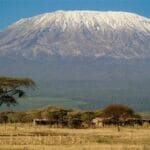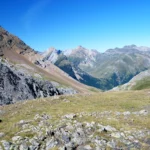Hey there, adventurers! Get ready to explore the Sutter Buttes, California’s mysterious “miniature mountain range.” These awesome peaks stand tall in the middle of the Sacramento Valley, like a tiny island of mountains. They’re not your average hills—they’re the result of ancient volcanic eruptions. They’re also full of history and stories, from Native American traditions to tales of settlers and gold miners. Plus, they’re a bit of a mystery, with challenges and secrets still waiting to be uncovered. Let’s take a closer look at these intriguing Sutter Buttes and discover what makes them so special.
A Geological Marvel in the Making
Imagine driving through the seemingly endless flat plains of California’s Sacramento Valley and then, boom! Out of nowhere, a cluster of rocky peaks pops up on the horizon. That, my friends, is the Sutter Buttes mountain range, a geological oddity that has captivated folks for centuries.
Millions of years ago, volcanic eruptions spewed lava onto the Earth’s surface. Over time, erosion sculpted those lava flows into the unique mounds we see today. They’re more like hills, honestly, spread out over about 10 miles. But don’t let their size fool you – the highest point, South Butte, still reaches over 2,000 feet, offering some pretty incredible views from the top.
Cultural Significance and a Legacy of Exploration
For the Maidu and Wintun tribes who have called this area home for generations, the Sutter Buttes are far more than just geological formations. These peaks are intertwined with their history, beliefs, and very identity. Their creation stories, passed down through countless generations, speak of the Buttes as sacred landmarks.
The Buttes were first “discovered” by European explorers in the 1800s. While there was some short-lived oil and gas exploration in the early 1900s, much of the land remains privately owned today. This makes accessing the Buttes a bit tricky, but not impossible. Keep an eye out for guided hikes offered by organizations like Middle Mountain Interpretive Hikes, which offer a rare glimpse into this restricted landscape.
A Delicate Ecosystem and a Conservation Challenge
Despite their relatively small size, the Sutter Buttes are home to a surprising variety of plants and animals. Over time, these species have adapted to the Buttes’ unique environment, creating a delicate and fascinating ecosystem.
The big question is, how do we protect this special place? You see, there’s some debate about whether the Sutter Buttes even qualify as a “real” mountain range, being the smallest in the world and all. But that debate misses the point. The Sutter Buttes, regardless of their official designation, are a treasure trove of natural and cultural heritage. It’s up to us to learn more, appreciate their significance, and work together to ensure their preservation for generations to come.
Is the Sutter Buttes the World’s Smallest Mountain Range?
The Sutter Buttes are often referred to as the “world’s smallest mountain range,” but this claim is more of a casual observation than a scientific fact. There’s no official organization out there measuring mountains and handing out awards! Besides, how do you even compare something as unique as the Sutter Buttes to a sprawling range like the Rockies or the Himalayas?
The debate over their size might make us miss the bigger picture. The Sutter Buttes are a testament to the power of geological processes, cultural heritage, and the evolving relationship between humans and nature. Their value lies not in size, but in the stories they tell. So, while the debate over their “smallest” status might continue, let’s remember to appreciate the Sutter Buttes for the one-of-a-kind wonder they truly are.
Are There Missile Silos in the Sutter Buttes?
Deep within California’s Central Valley, the Sutter Buttes rise unexpectedly from the flat landscape. Most folks know them as a geological oddity, but they hold a secret from a time when the world was on edge. Back in the Cold War, when the threat of nuclear war was a terrifying reality, the US government was busy building Titan I missile silos all over the country. The Sutter Buttes, with their strategic location and unique geology, seemed like the perfect spot for three of these imposing structures.
This complex, known as 851-B, was active from 1961 to 1965. Picture this: massive Titan I intercontinental ballistic missiles hidden within silos that burrowed nearly 160 feet underground! It was a time of immense tension, and these silos were a powerful symbol of the stakes involved.
By 1965, as the Cold War began to thaw, the Titan I program was retired, and the Sutter Buttes silos were officially deactivated. But their presence lingers. Though silent now, they stand as a reminder of a period in history when the world held its breath, uncertain of what the future held. It’s fascinating to think that these seemingly quiet mountains played a role in such a pivotal time.
Which Is the Lowest Mountain Range in the World?
The title of “lowest mountain range in the world” is difficult to definitively award, as there are varying definitions of what constitutes a mountain range. Some might consider submerged mountain chains beneath the ocean, while others focus on ranges above sea level.
The south american mammal with a flexible snout and the suyo long cucumber showcase the incredible diversity of life on our planet. Likewise, the Sutter Buttes, with their unique geological formations and cultural significance, deserve recognition and protection. They remind us that even in the most unexpected places, wonders await to be discovered.
- Georgia Platform: A Southern Strategy, 1850s - March 31, 2025
- How many weeks is 40 days: Quick Conversion Guide for Accurate Results - March 31, 2025
- How many feet is 300 meters? 984 Feet: Understand Length Conversions Easily - March 31, 2025
















